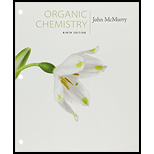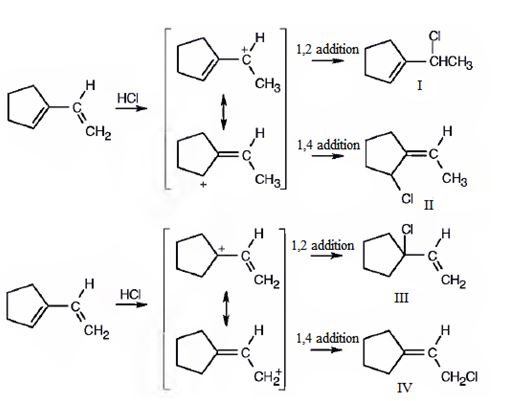
Concept explainers
Interpretation:
The structures of all possible adducts obtainable when the diene given reacts with one equivalent of HCl are to be given.
Concept introduction:
Conjugated dienes undergo electrophilic addition reactions through the formation of an allyl carbocation. The allyl cation is resonance stabilized and the attack of chloride ion on each of these forms leads to the formation of a mixture of 1, 2- and 1, 4-addition products.
To give:
The structures of all possible adducts obtainable when the diene given reacts with one equivalent of HCl.
Answer to Problem 16VC
The compound given is 1-vinylcyclopentene.The structures of all the possible adducts obtained when it reacts with one equivalent of HCl are given below.

Explanation of Solution
1-Vinylcyclopentene is an unsymmetrical conjugated diene. Protonation of the CH2 in double bond and that in the ring lead to the formation of two different allyl carbocations, each of which is in resonance with another form. Hence four carbocations as shown are possible. Attack of the chloride ion on each of these carbocation leads to the formation of four different products.

The compound given is 1-vinylcyclopentene.The structures of all the possible adducts obtained, when it reacts with one equivalent of HCl, are given below.

Want to see more full solutions like this?
Chapter 14 Solutions
Student Value Bundle: Organic Chemistry, + OWLv2 with Student Solutions Manual eBook, 4 terms (24 months) Printed Access Card (NEW!!)
- how to get limiting reactant and % yield based off this data Compound Mass 6) Volume(mL Ben zaphone-5008 ne Acetic Acid 1. Sam L 2-propanot 8.00 Benzopin- a col 030445 Benzopin a Colone 0.06743 Results Compound Melting Point (°c) Benzopin acol 172°c - 175.8 °c Benzoping to lone 1797-180.9arrow_forwardAssign ALL signals for the proton and carbon NMR spectra on the following pages.arrow_forward7.5 1.93 2.05 C B A 4 3 5 The Joh. 9 7 8 1 2 7.5 7.0 6.5 6.0 5.5 5.0 4.5 4.0 3.5 3.0 2.5 2.0 1.5 1.0 ppm 9 7 8 0.86 OH 10 4 3 5 1 2 7.5 7.0 6.5 6.0 5.5 5.0 4.5 4.0 3.5 3.0 2.5 2.0 1.5 1.0 ppm 9 7 8 CI 4 3 5 1 2 7.0 6.5 6.0 5.5 5.0 4.5 4.0 3.5 3.0 2.5 2.0 2.21 4.00 1.5 2.00 2.07 1.0 ppm 2.76arrow_forward
- Assign the functional group bands on the IR spectra.arrow_forwardFind the pH of a 0.120 M solution of HNO2. Find the pH ignoring activity effects (i.e., the normal way). Find the pH in a solution of 0.050 M NaCl, including activityarrow_forwardPlease help me answer these three questions. Required info should be in data table.arrow_forward
- Draw the major organic substitution product or products for (2R,3S)-2-bromo-3-methylpentane reacting with the given nucleophile. Clearly drawn the stereochemistry, including a wedged bond, a dashed bond and two in-plane bonds at each stereogenic center. Omit any byproducts. Bri CH3CH2O- (conc.) Draw the major organic product or products.arrow_forwardTartaric acid (C4H6O6) is a diprotic weak acid. A sample of 875 mg tartaric acid are dissolved in 100 mL water and titrated with 0.994 M NaOH. How many mL of NaOH are needed to reach the first equivalence point? How many mL of NaOH are needed to reach the second equivalence point?arrow_forwardIncluding activity, calculate the solubility of Pb(IO3)2 in a matrix of 0.020 M Mg(NO3)2.arrow_forward
